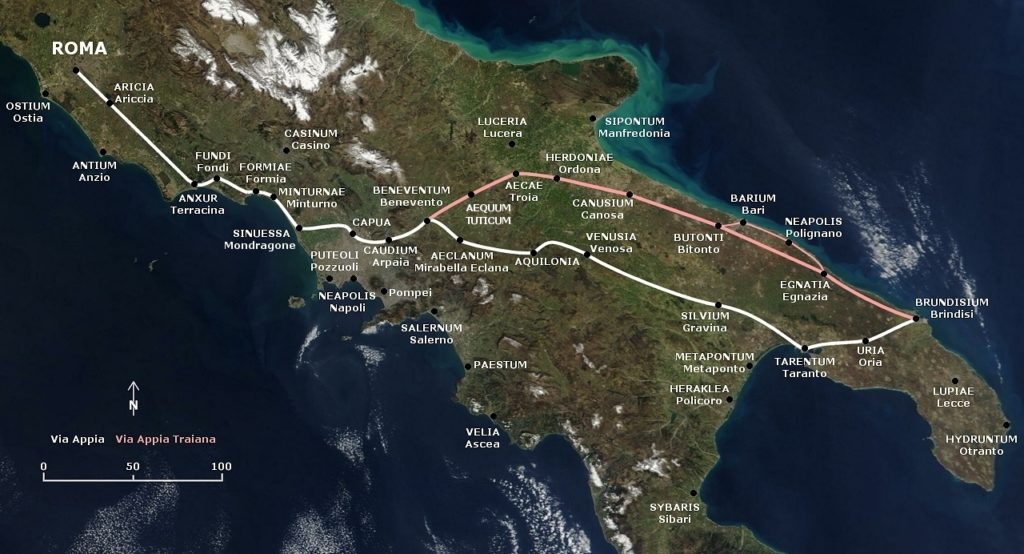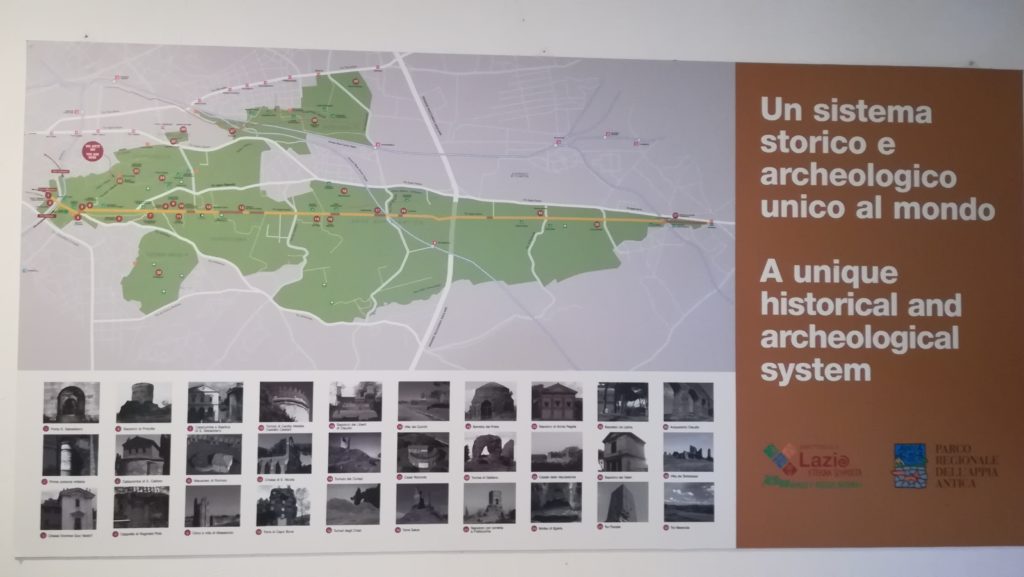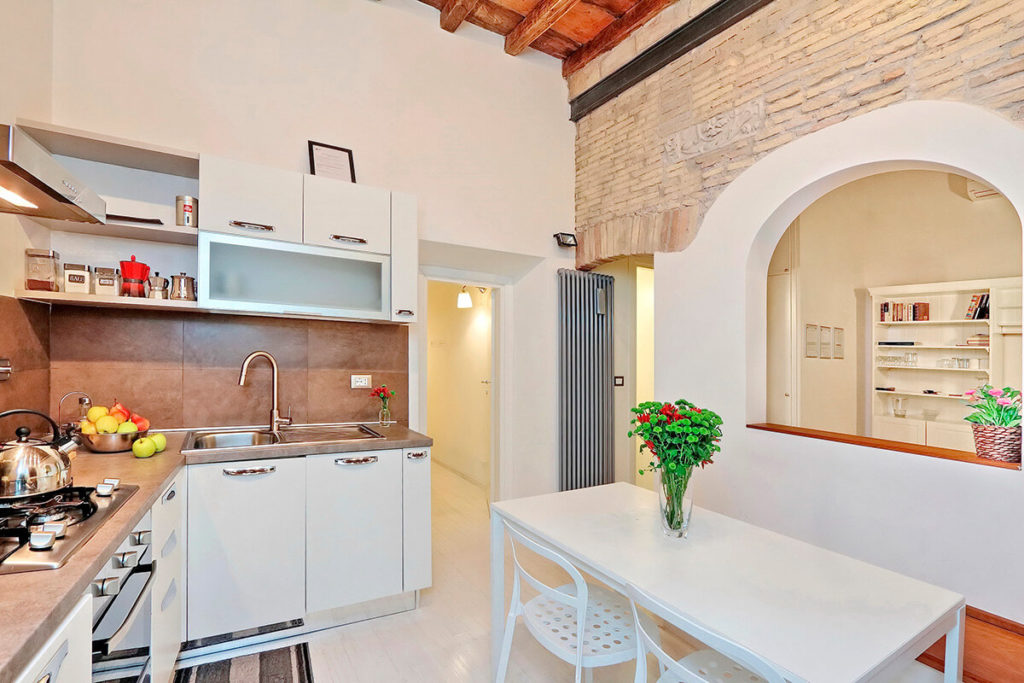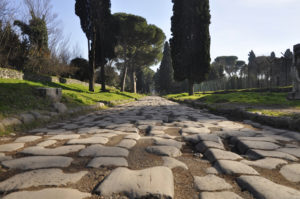As the saying goes All roads lead to Rome…and one of the most famous of those roads is the Appia Antica, or the Appian Way. Finished in 312 B.C. by censor Appius Claudius Caecus for which the road takes its name, the road connects Rome with Brindisi in the southeast “heel” of the Italian peninsula. The road was originally constructed to transport military troops during the Samnite Wars, crossing the particularly dangerous maleria-ridden marshlands between Rome and modern-day Naples.
The Romans were skilled road builders. The road was constructed on leveled earth, on which layers of gravel and cement provided a base. Finally interlocking blocks of resistant volcanic stone were positioned and sealed so tightly that it was difficult to see the seams. The roads was slightly concave to allow water runoff, featured reinforced gutters on the sides, and even leveled dirt sidewalks.
Since it wasn’t possible to bury the dead within the city walls, impressive and humble tombs lined the roads that led into the city. Today it is still possible to walk the same volcanic stone-paved road, though the cement that sealed the stones has since deteriorated leaving a less smooth surface, and admire the ruins of the tombs, villas, baths, and even a circus within the first 10 miles that makes up the regional park.

Visit the Appian Way
While the ancient Appian Way finished at the Roman Forum, today it starts at the Baths of Caracalla. The first mile or so is less pedestrian friendly since it is trafficked by cars, so it may be better to start any excursion directly from the Porta di San Sebastiano or the Church of Domine Quo Vadis.
On Foot
Reach a good starting point for the Parco Regionale di Appia Antica by taking either bus 118 or 218, which both offer service to the Porta and the church. The nearest metro on the other hand is Circus Maximus, and about a 20-30 minute walk to the less trafficked part of the Appian Way.
From here you can start your self-guided tour of the Appian Way on foot. Be sure to wear comfortable walking shoes as the dense stone road is hard on the joints. Also be sure to bring water and a snack with you as you won’t find many places along the way to purchase anything. The Appian Way makes a great running route in the morning or late afternoon walk before dinner. During the summer months, the walk can be difficult for those not used to a lot of physical activity since parts of the road don’t provide shade.
By Bicycle
Bicycle rental is available through Eco-Bike Rent, with their office located near the beginning of the park at Via Appia Antica 58. They offer a selection of bicycles for rent, including classic adult bikes, children’s bikes, electric bikes and even electric golf carts to explore the park. Prices start at €3/hour or €15/day. Book online.
On Horseback
As the other saying goes, Do as the Romans Do and experience the ancient road from the back of a horse! Horseback riding tours on the Appian Way are available through Riding Ancient Rome, which offers various itineraries depending on group preferences, ages and skill. Let a guide ride with you and explain the history of the road and the monuments that line the way. Stop for a picnic or a romantic meal along the way as well.
Highlights along the Appian Way
The Regional Park of the Appian Way offers special itineraries to admire the various ruins and monuments along the Appian Way. Below are a few of the highlights you can expect to see as the walk this ancient road:

Tombs
At the beginning of the park after the trafficked part, the Tomb of Priscilla, constructed in the 1st century for the wife of Titus Flavius Abascanto, a freedman under Dominition, is located near the Church of Domine Quo Vadis. Further down the road the Tomb of Caecilia Metella, also built during the 1st century and dedicated to the wife of Marcus Licinius Crassus, son of Marcus Crassus, an official who served under Julius Caesar. The tomb of Tomb of Hilarus Fuscus is located near the end of the 4th mile and likely built in 30 B.C.
Catacombs
There are 3 major catacombs that are open to visitors along the Appian Way: Catacombs of Callixtus (most well known for containing the Crypt of the Popes where tombs of the Popes who served in the 2nd through 4th centuries were buried); Catacombs of San Sebastiano (home of a small church and the tomb of Saint Sebastian); and the Jewish catacombs Vigna Randanini (which were often confused with the Catacombs of San Sebastiano since they are located near each other).
Circus of Maxentius
The ancient Circus of Maxentius, like the Circus Maximus or Domitian Stadium, was constructed to host chariot races among other public spectacles in ancient Rome – but likely was never used for such. Today you can admire the ruins of what’s left of the circus’ towers and the adjacent Villa Maxentius. There was originally an obelisk located at the center of the circus which became hotly contested during the Renaissance for what should be done with the 5-pieces that had been discovered during the time. Ultimately Pope Innocent X had the obelisk reconstructed and installed in the center of Piazza Navona to crown his new Fontana dei Quattro Fiumi.
Looking for a place to stay in Rome?

AP56 Campo de’ Fiori II vacation rental by ROMAC, just around the corner from Campo de’ Fiori and it’s colorful outdoor market.
Deborah K. from the US said about the AP56 Campo de’ Fiori vacation rental by ROMAC:
I wanted to Thank You for the wonderful stay we had in this apartment and with the services you provided. The apartment exceeded our expectations as did the service provided by Francesco. Please let him know that sharing his recommendations of places to visit in Rome enriched our short time there.
The car service to FCO airport Francesco arranged was also excellent. I’m sorry I didn’t get the drivers name but he made our last moments in Rome fantastic.—I do not exaggerate in saying this. His car was comfortable, he pointed out previously unknown sights and gave us a very memorable last impression of Rome.
I highly recommend your company and will do so to others. I look forward to staying in an apartment with your company again.
ROMAC has been welcoming international visitors to Rome for over a decade. Browse our collection of over 40 vacation rentals in the center of Rome at ROMAC, and use filters to narrow your search by neighborhood, number of guests, price and amenities! Our dedicated team of international staff are eager to help you organize your visit, provide insider tips and advice for making the most of your vacation in Rome, and make your travel experience seamless. Contact us today to start planning your vacation in Rome!
Have you visited the Appian Way? Share your experiences in the comments below!

















[…] as well. From running around the historic center to out in the country along the multi-millenia old Appian Way, a good run through Rome is an experience to […]